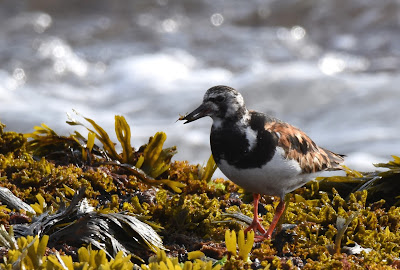 |
| Semipalmated Plover |
 |
| Ruddy Turnstone |
 |
| Sanderlings |
 |
| Least Sandpiper |
Stilt legs and a long beak suit him perfectly to harvesting the niche.
 |
| Semipalmated Sandpiper (L) and Least Sandpiper (R) |
 |
| Semipalmated Sandpiper and juvenile Spotted Sandpiper |
 |
| Spotted Sandpiper |
Spotted Sandpipers are the only members of the clan to nest in this area, and the only one to come to the fresh-water quarries on Halibut Point. Most shorebirds pass through in the spring en route to Arctic breeding grounds. Adults start arriving here by mid July, through September, on their way to South America.
 |
| Ruddy Turnstone |
One elegant sandpiper relative has been in residence on the
shoreline since early August. This pair of Ruddy Turnstones joined the
Semipalmated and Spotted Sandpipers at a promising hunting ground.
 |
| Ruddy Turnstone, breeding plumage |
The turnstones--named for their hunting method on a pebble
beach--found shrimp-like prey in the seaweed.
 |
| Ruddy Turnstone, juvenile plumage |
This juvenile turnstone was happy to pick through a crab
carcass demolished by a gull. The adults had already headed south. Young ones
find their way to the wintering grounds unaccompanied by the adults. Some
species migrate seasonally from the Arctic all the way to Tierra del Fuego, a
distance of 10,000 or more miles. Plumping up in advance stores energy for the
flight.
 |
| Purple Sandpipers |


No comments:
Post a Comment